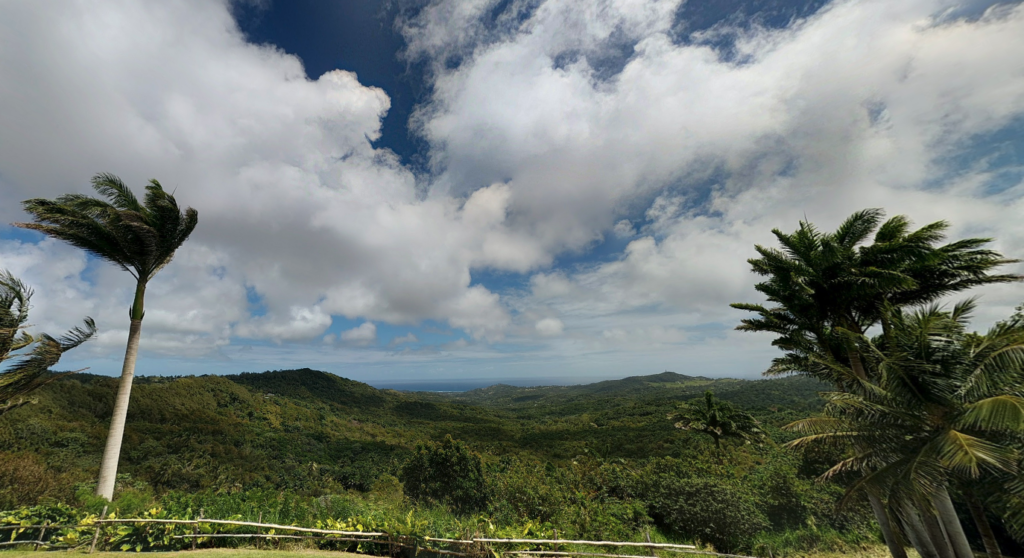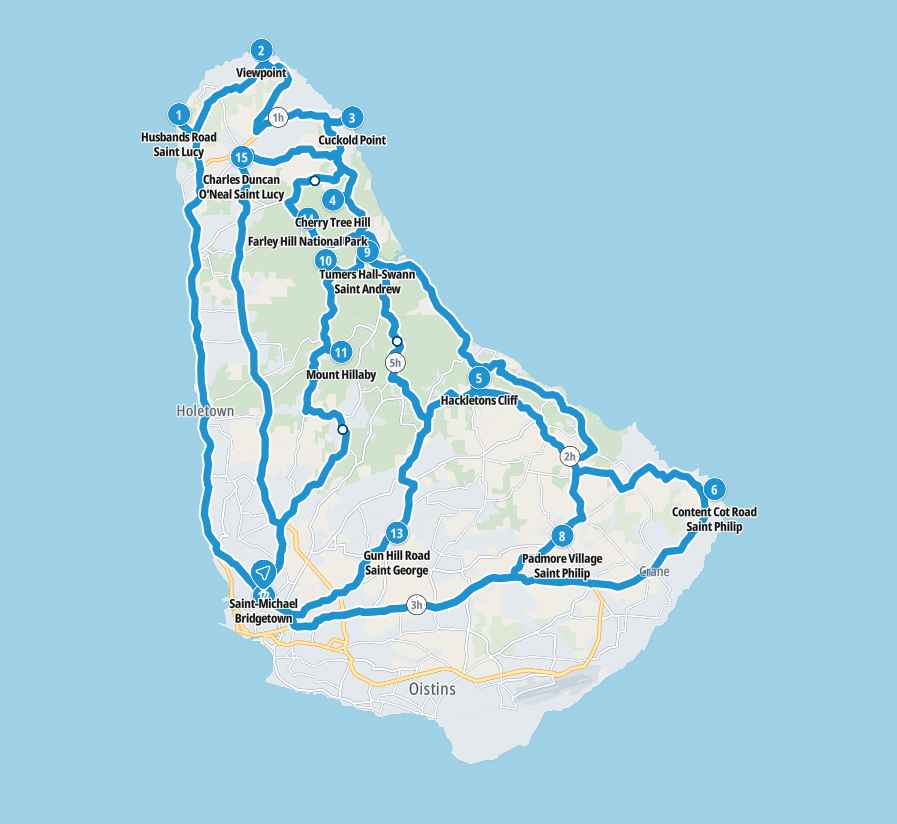Barbados – Let’s explore here

What’s it like in Barbados?
Barbados is a small island in the Atlantic Ocean that’s the most eastern of all the Caribbean islands. It’s a relatively small country, just a bit larger than the Isle of Wight, England, UK, being approximately 21 miles (34 km) long and 14 miles (23 km) wide.
There are no mountains on Barbados with only a small central highland region known as Scotland District. The highest point is Mount Hillaby at 1,120 ft (340m) above sea level.
Barbados’ population is around 282,000 (2023) and its capital, Bridgetown is home to around 110,000 people. It relies heavily on tourism like many other Caribbean islands.

A bit about the history of Barbados
Early History and Indigenous Peoples
Before European colonisation, Barbados was inhabited by the Arawak and Carib peoples, who arrived from South America. They lived off fishing, farming and hunting. However, by the time Europeans arrived, the island had been largely depopulated due to diseases and conflicts.
European Discovery and Colonisation
In 1536, the Portuguese first encountered Barbados, but it was the English who began settling the island in 1627. The English established a plantation economy, initially growing tobacco and cotton, later focusing on sugar production. African slaves were forcibly brought to the island to work on the sugar plantations.
Slave Trade and Sugar Economy
Barbados became one of the most profitable colonies in the British Empire due to its sugar industry. The reliance on enslaved African labour led to the rapid growth of the island’s population, with African slaves making up the majority of the population. Barbados was known for its brutal slave system and high sugar exports.
Abolition of Slavery and Post Slavery Era
Slavery was abolished in the British Empire in 1834, including in Barbados. Following emancipation, many former slaves continued to work on plantations, although the island’s economy started to diversify. There were efforts to establish education and social reforms, but significant inequality remained.
Towards Self Governance
In the early 20th century, Barbados began to push for greater political rights and self governance. This culminated in the establishment of universal suffrage in 1951 and a gradual transition to self rule. By 1961, the island had full internal autonomy, and in 1966, Barbados gained independence from Britain while remaining a member of the Commonwealth.
Independence and Modern Era
Since gaining independence in 1966, Barbados has developed into a stable democracy with a strong economy based on tourism, sugar and offshore finance. The country has maintained political stability and high standards of living, but like many small island nations, it faces challenges such as vulnerability to natural disasters, climate change and global economic shifts. Barbados remains a constitutional monarchy, with the British monarch as the ceremonial head of state, and a Prime Minister as head of government. The island has continued to invest in infrastructure, education and social services while striving to maintain its historical cultural identity.

Barbados road trip
Barbados is our fifth planned stop on our road trip through the islands of the Caribbean. Having explored Trinidad and Tobago, our next stop is Grenada.
Travelling overland between the islands is quite prohibitive due to the lack of transportation options. Travelling between different island countries via ferry is possible, however, ferries only operate between some islands. Chartering private boats between islands is also possible, although travelling with a car in this way is prohibitive. Flying is another option, although again, flights only operate between some islands.
Map of our road trip through Barbados

This is a map of our planned road trip around the island of Barbados, starting and ending in the capital, Bridgetown.
Weather in Barbados
When is the best time to visit Barbados?
The best time to visit Barbados is from January to April. During these months, the islands have 8 hours of sunshine per day and rainfall of 1.5 – 3.0 inches (38 – 76mm) per month. The temperature ranges from 21 – 31°C (70 – 88°F).
When is the worst time to visit Barbados?
The worst time to visit Barbados is from June to September. During these months, the islands still have 8 hours of sunshine per day. However, humidity rises and it rains an average of 6.0 – 7.0 inches (152 – 178mm) per month. The temperature ranges from 23 – 31°C (74 – 88°F).
Hurricane Season in the Caribbean
Hurricane season in the Caribbean runs from June 1 to November 30. Storms tend to be more frequent and more severe in the latter half of the season.
Hurricanes are least likely during December, January and February.
Travel in and around Barbados
Ferries to and from Barbados
Unfortunately, there are no ferries to other island countries in the Caribbean from Barbados (2024).
What’s it like to drive in Barbados?
Car hire is available in Barbados and the main roads are well maintained. However, many minor roads are poorly maintained, many with large potholes.
A Barbados driving licence is required to drive in Barbados. You can buy one from a car hire company or online from the Barbados Revenue Authority. You must also carry your UK driving licence.
We’ve also created a dedicated page to driving abroad, which you might find helpful 🙂
What currency do they use in Barbados?
In Barbados they use the Barbadian dollar. Cash is widely used. The use of credit / debit cards is widely accepted in major cities, although not in rural areas. Travellers cheques are not accepted in the main. There are ATMs in cities, although not all accept foreign issued cards.
You should make yourself aware of the amount that your bank charges you for using credit and debit cards abroad. Often credit cards are cheaper for purchasing items directly, and for withdrawing cash from ATMs.
What language do they speak in Barbados?
They speak English and Creole in Barbados. English is spoken in tourist areas.
What time zone is Barbados in?
Remember, when you’re planning your next trip to take a look at what time zone it’s in.
Do I need a visa to visit Barbados?
We’ve created a dedicated, more comprehensive page on visas, which you should find helpful. Check it out!
Is wild camping legal in Barbados?
No, wild camping is not widely accepted in Barbados.
What plug / socket type do they use in Barbados?
In Barbados they use plug / socket types A and B.


Health issues in Barbados
Is it safe to drink water in Barbados?
Yes, it is safe to drink tap water in Barbados. Bottled water is also readily available across the country.
What vaccinations are required for Barbados?
This NHS website is kept up to date with all relevant information on vaccinations in Barbados.
Phones in Barbados
What is the country calling code for Barbados?
The country calling code for Barbados is +1 246
What are the emergency phone numbers in Barbados?
- The emergency number for police in Barbados is: 211
- In Barbados, the emergency number for ambulance is: 511
- The emergency number for fire in Barbados is: 311
If you’ve got some useful info that you’d like to share, let us know!
And don’t forget to check out all the other pictures!
